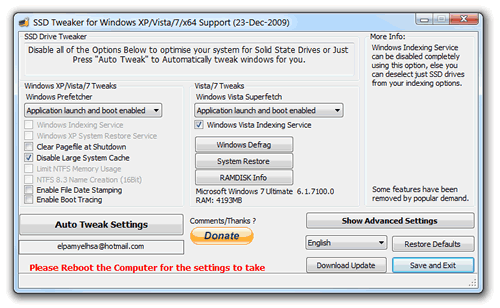I have the following desktop: www.techcomet.com/p/my-gadgets.html
My “MO” is generally to keep things “default” unless there is a good reason why I should change the way something is set up.
An example is that I read SSDs wear out over time so it is better to put the paging file on a separate disk. Hence, I created a dedicated partition on my 1TB HD and put my paging file there. The partition is 10GB and the paging file can go up to a total of 9GB (I have 6GB of RAM).
I have read articles that I suggest I move my Photoshop CS5 scratch disk of my SSD onto a separate hard drive. Hence, I made my paging file partition bigger and put the scratch disk there. I don’t deal with a lot of massive photoshop files, so this shouldn’t be a big deal, but again I want the best performance with the least hassle.
So, my questions are:
1. Where should the paging file be placed and approximately how big should it be?
2. Where should the Photoshop scratch disk be placed?
3. Should I move my temp folders off my SSD (i.e. move them to my HD)?
4. Are there any other hardware or optimization tweak that would benefit the speed or longevity of my system?
Again like I said I don’t like trying out every obscure hack, for one thing there is so much disagreement over these hacks that it is difficult to figure out what is the best thing to do.
Anyway, thanks for helping!
My “MO” is generally to keep things “default” unless there is a good reason why I should change the way something is set up.
An example is that I read SSDs wear out over time so it is better to put the paging file on a separate disk. Hence, I created a dedicated partition on my 1TB HD and put my paging file there. The partition is 10GB and the paging file can go up to a total of 9GB (I have 6GB of RAM).
I have read articles that I suggest I move my Photoshop CS5 scratch disk of my SSD onto a separate hard drive. Hence, I made my paging file partition bigger and put the scratch disk there. I don’t deal with a lot of massive photoshop files, so this shouldn’t be a big deal, but again I want the best performance with the least hassle.
So, my questions are:
1. Where should the paging file be placed and approximately how big should it be?
2. Where should the Photoshop scratch disk be placed?
3. Should I move my temp folders off my SSD (i.e. move them to my HD)?
4. Are there any other hardware or optimization tweak that would benefit the speed or longevity of my system?
Again like I said I don’t like trying out every obscure hack, for one thing there is so much disagreement over these hacks that it is difficult to figure out what is the best thing to do.
Anyway, thanks for helping!

